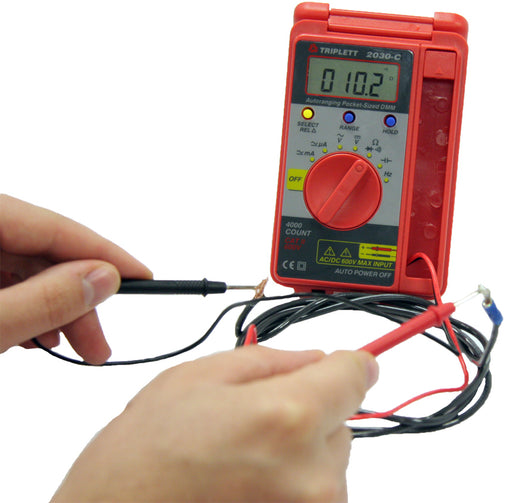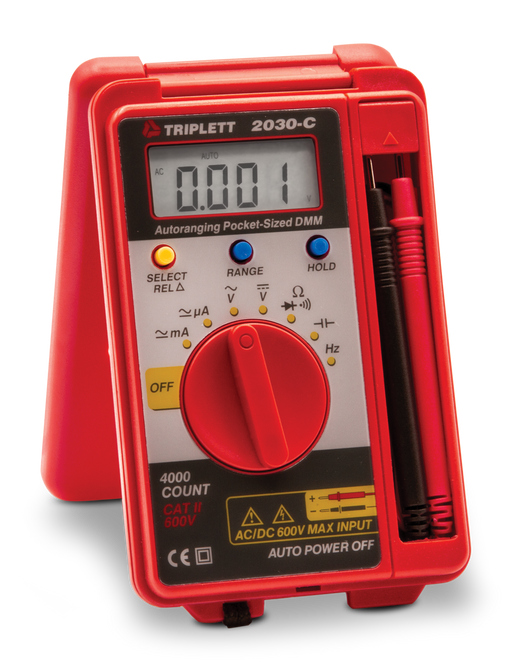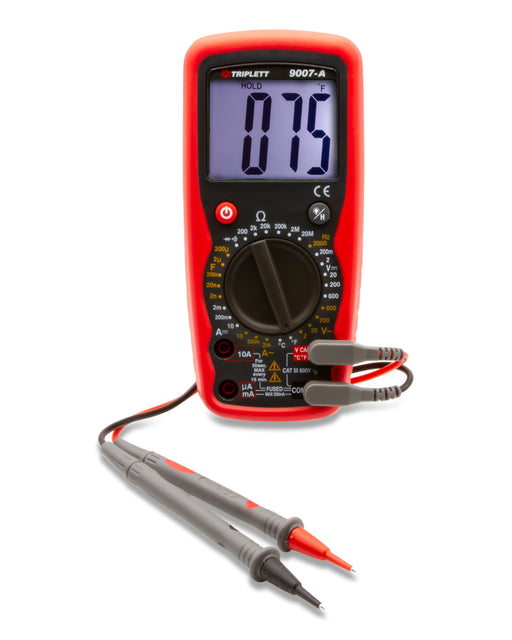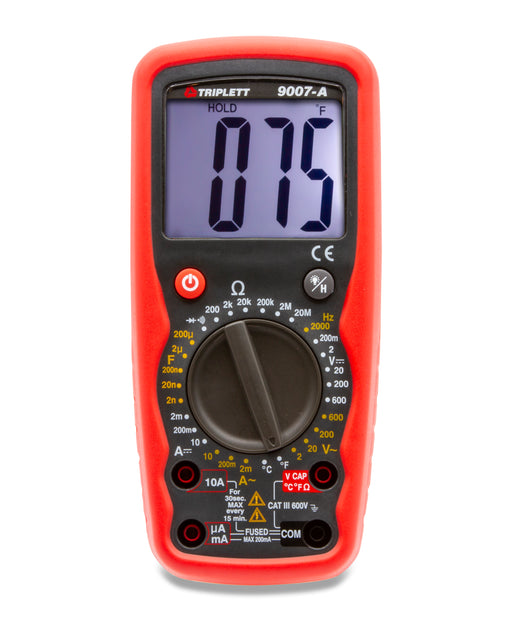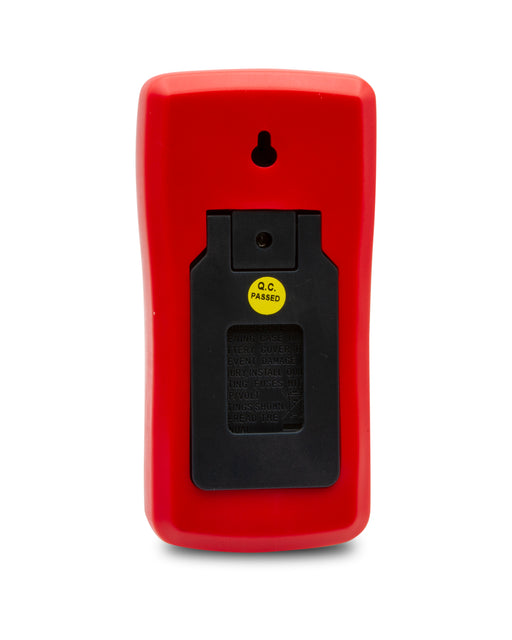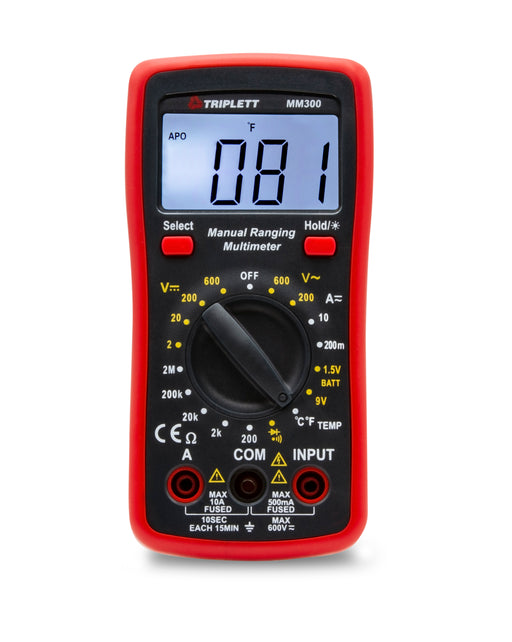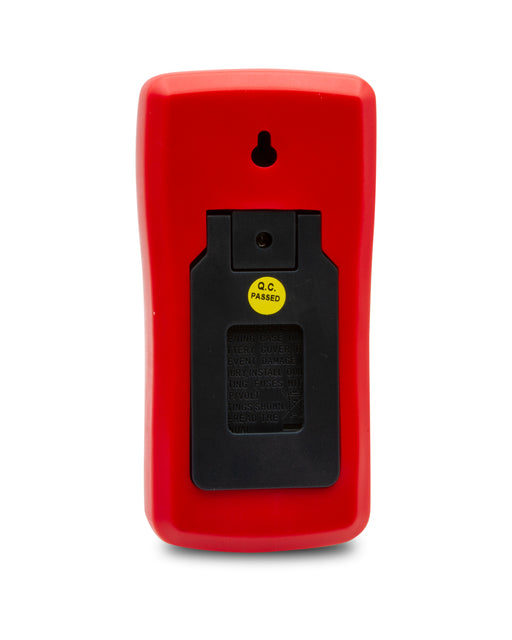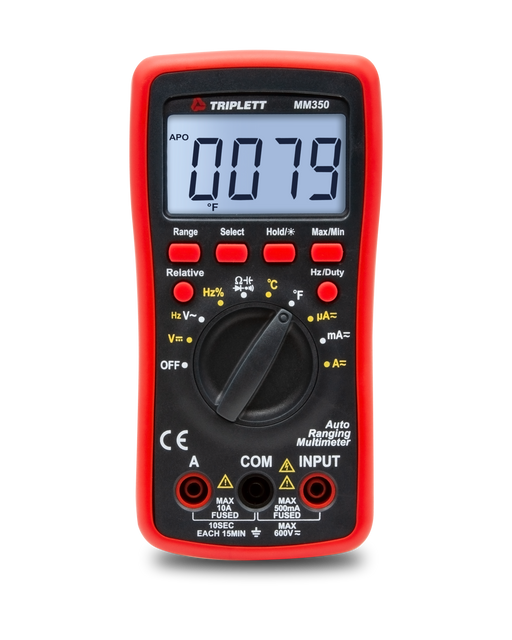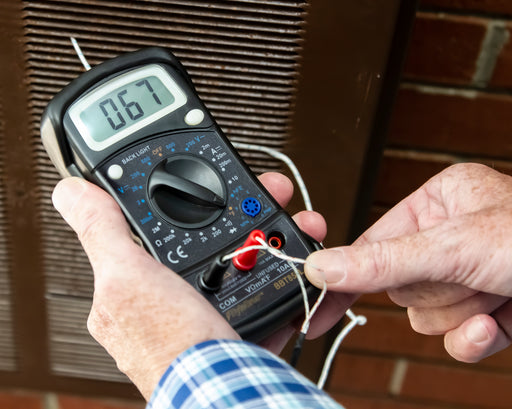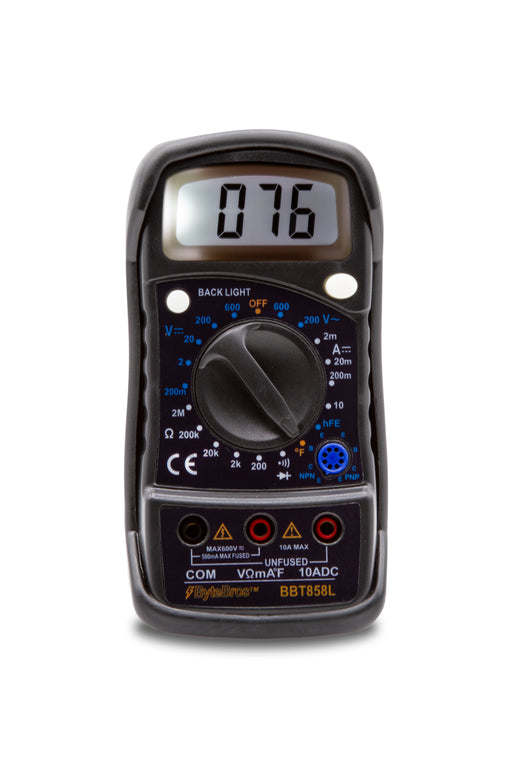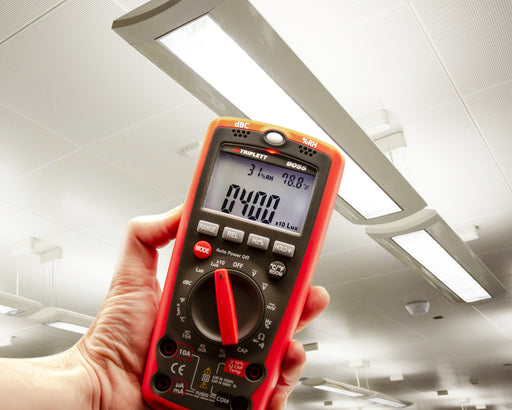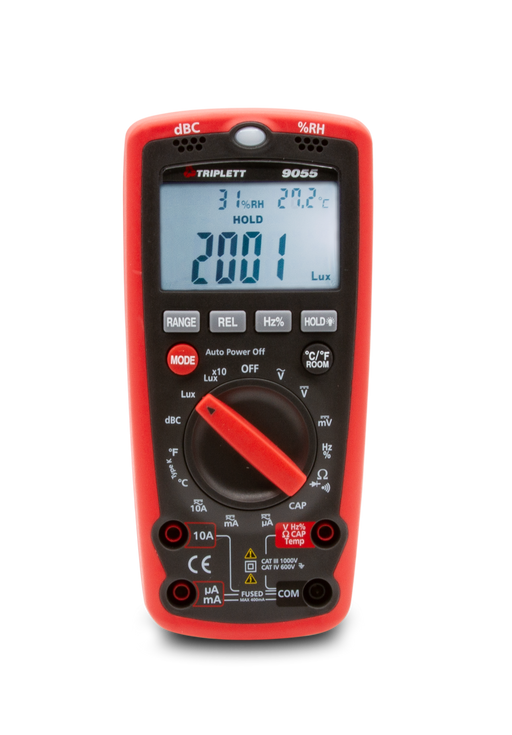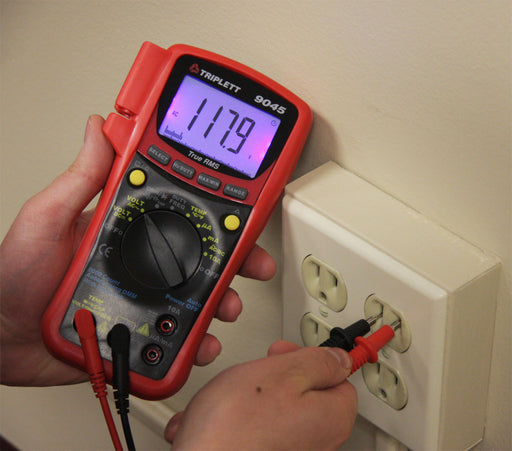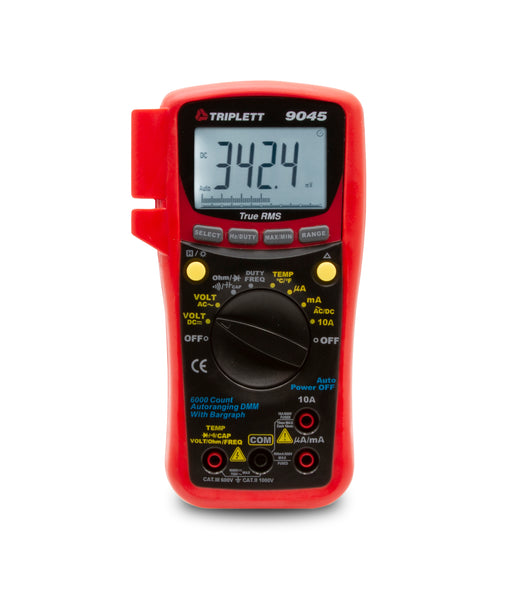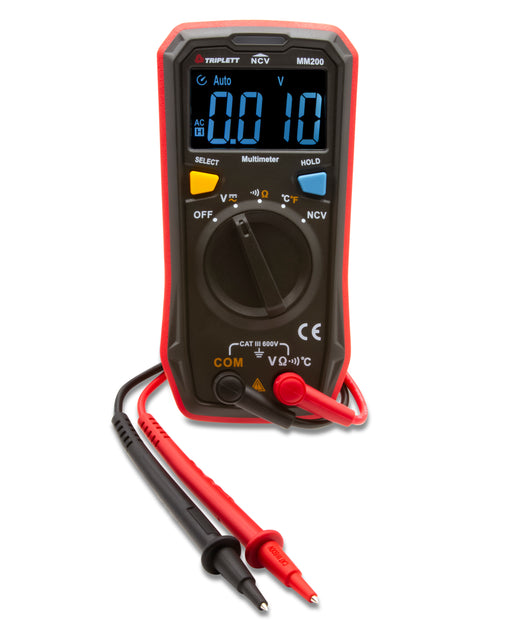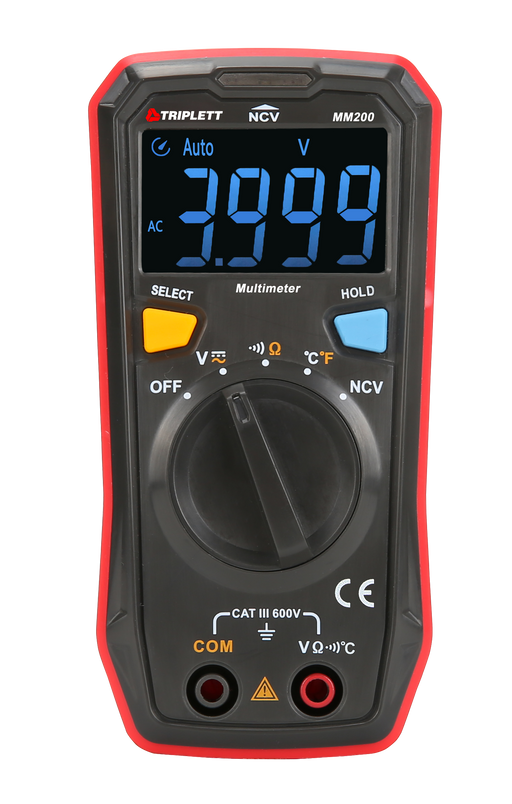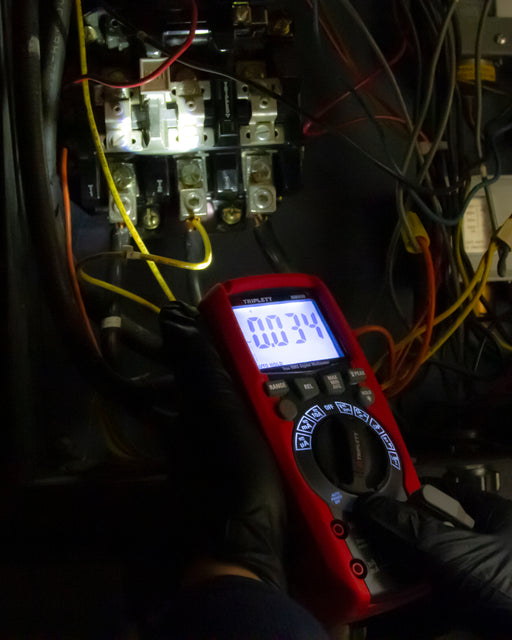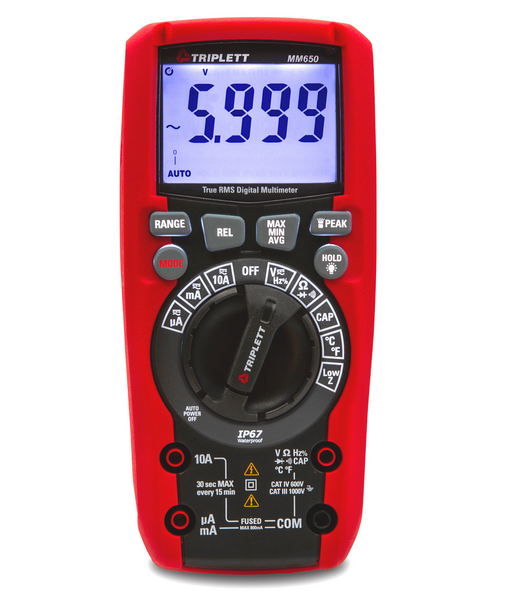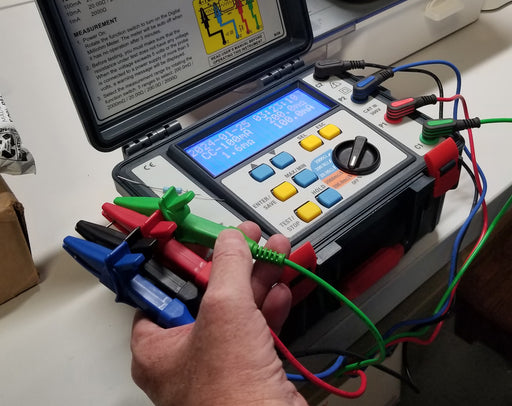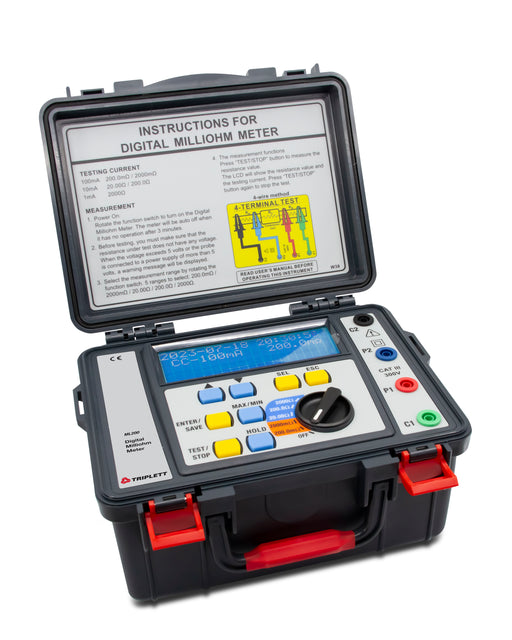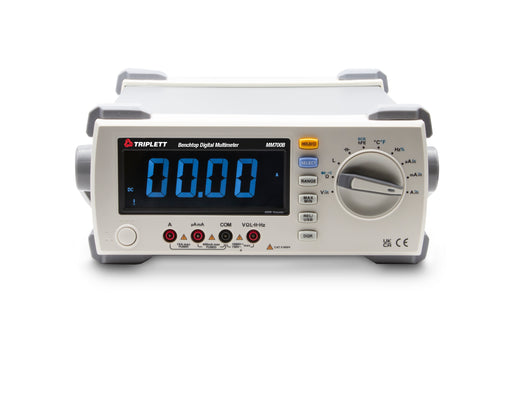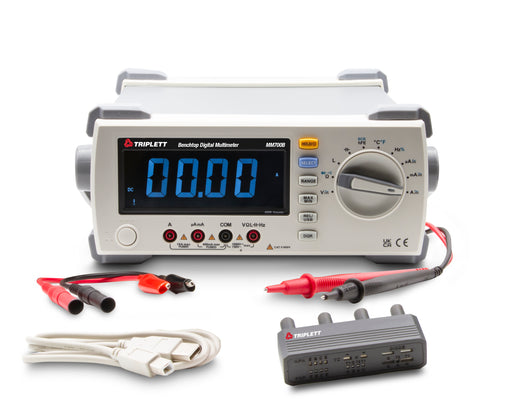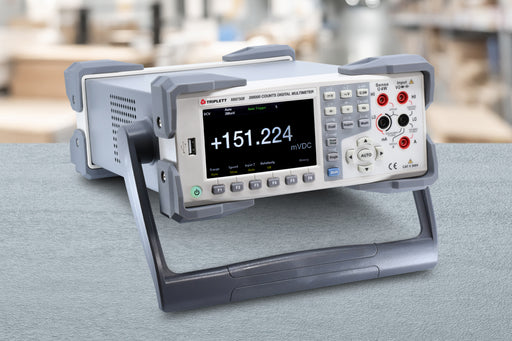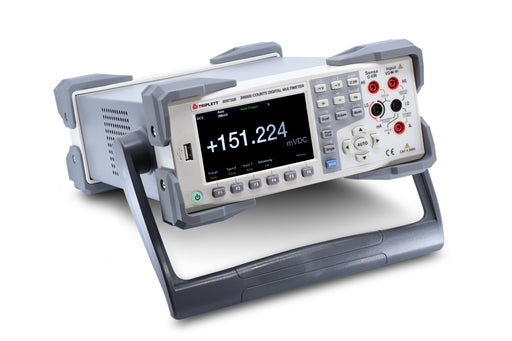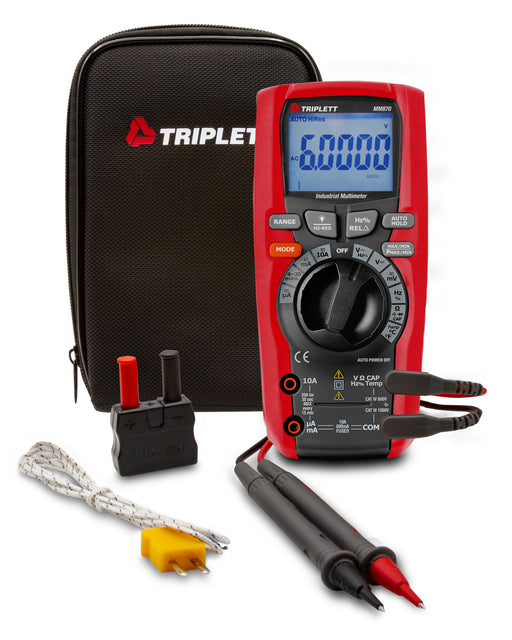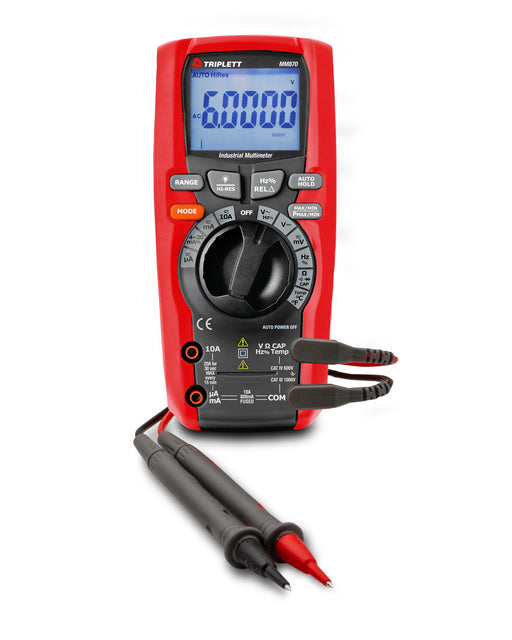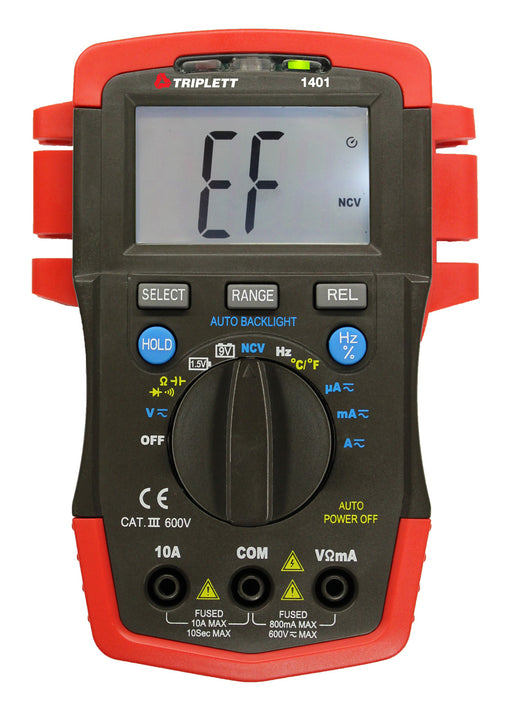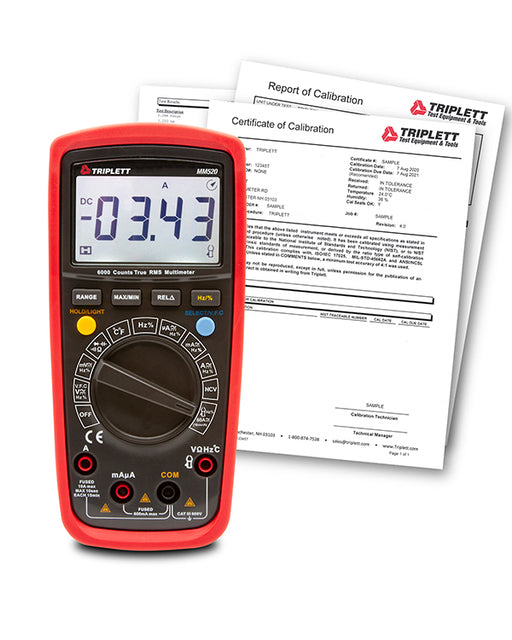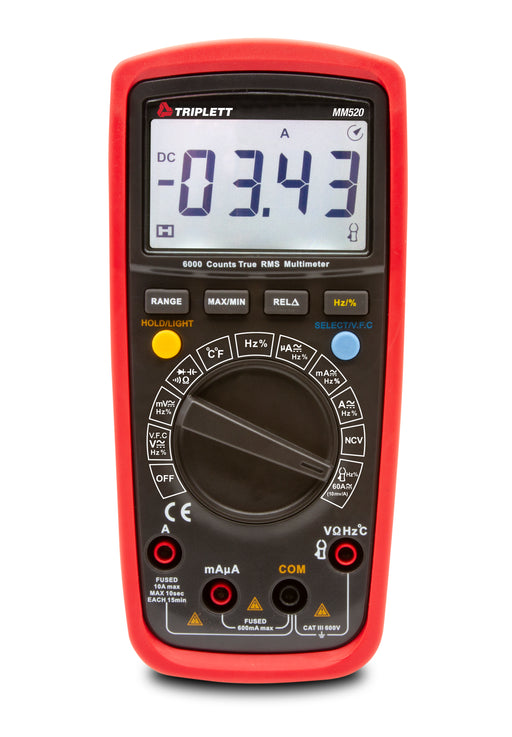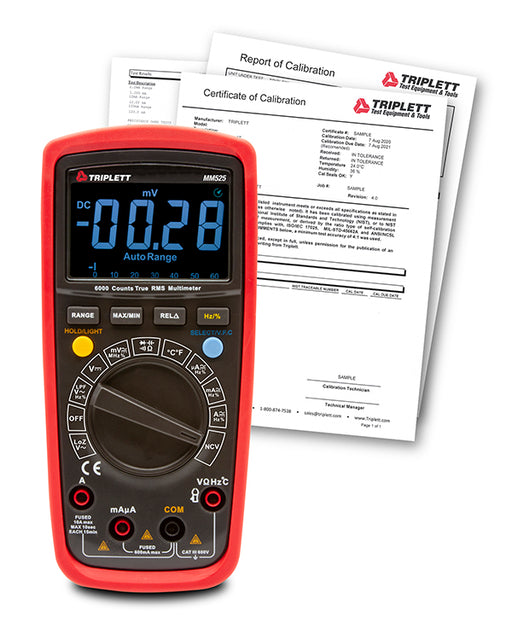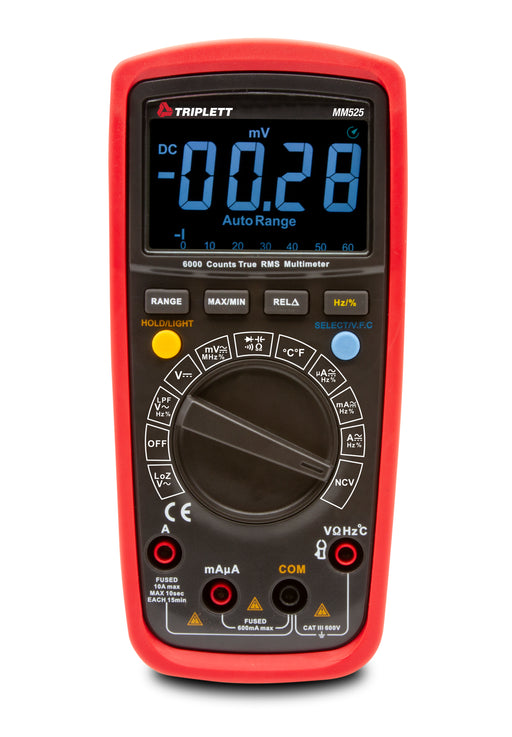
Digital Multimeters
Digital multimeters, or DMMs are devices capable of measuring multiple electrical values, AC/DC voltage/current and resistance plus diode test and continuity. Advanced functions include Temperature, Capacitance and Frequency measurement plus Low Pass Filter (LPF) and Low impedance mode (Lo-Z). Triplett is an industry-leading manufacturer and supplier of digital multimeters for the electronics industry. Our commercial multimeters are designed for portability and ideal for remote testing applications. They are tested for reliability, accuracy and precision in measurement, and extended battery life. DMMs are available with various features and specifications. To choose the best digital multimeter for your needs, scroll through the selection below.
Filters
Categories
-
Building, Maintenance, and Environmental
- Borescopes & Inspection Cameras
- Laser Distance Meters
- Photo & Contact Tachometers
- Manometers
- CO & CO2 Meters
- F Connectors
- Combustible Gas Detector and Pen
- Humidity Indicators & Meters
- Pin & Pinless Moisture Meters
- Thermometers
- Light Meters
- Sound & Noise Level Meters
- Particle Counter
- Thermo Anemometers
- Hygro-Thermometers
- Hygrometer
- Special Kits
- Refractometer
- Coating Thickness Testers
- PH and Conductivity Meters
-
Electrical Test & Measurement
- Analog Meters -Voltmeters
- Clamp Meter
- Digital Multimeters
- Railroad Test Sets
- Voltage & Current Dataloggers
- Magnetic Field Detectors
- AC Voltage Detector
- Continuity Testers
- Test Leads
- Multimeter Case
- GFCI Receptacle Testers
- Electrical Hand Tools
- Non-Contact Voltage Detection Pens
- Circuit Breaker Tracers
- Special Kits
- Megohmmeters - Insulation Testers
- Power Supplies
- Motor & Phase Rotation Testers
-
Security, CCTV & Cabling Equipment
- Security Camera Testers
- CCTV HD LED Test Monitors
- Baluns, Ground Loop Isolators
- HDMI & IP Extenders
- All Cables
- HDMI Cables
- CAT6a Shielded Cable
- Ethernet Network Cables
- CCTV BNC Adapters
- BNC Connectors
- F Connectors
- BNC Compression Connectors
- CAT5 & CAT6 Connectors
- CCTV Coax Connectors
- Modular Connector
- Between Series Adapters
-
Best SellerOriginal price $34.95 - Original price $34.95Original price$34.95$34.95 - $34.95Current price $34.95| /
3 ¼ Digit 4000 Count Pocket Digital Multimeter: CAT II 600V - (2030)
TriplettIn stock0 Reviews
The Triplett Model 2030-C is a 3-3/4 digit (4000 count) pocket sized digital multimeter with a built-in hard case. It offers a variety of measureme...
View full detailsOriginal price $34.95 - Original price $34.95Original price$34.95$34.95 - $34.95Current price $34.95| / -
Original price $0.00 - Original price $0.00Original price$0.00$0.00 - $0.00Current price $0.00| /
3 ½ Digit 1999 Count Compact Digital Multimeter: 19 Ranges, CAT II 600V - (1101-B)
TriplettOut of stock0 Reviews
The Triplett Model 1101-B has been discontinued This product has been replaced with the Triplett MM300 Please visit the MM300 page CATEGORY: DIGI...
View full detailsOriginal price $0.00 - Original price $0.00Original price$0.00$0.00 - $0.00Current price $0.00| /Out of Stock -
Original price $89.99 - Original price $164.19Original price$89.99 - $164.19$89.99 - $164.19Current price $89.99| /
3 ½ Digit 2,000 Count Industrial Digital Multimeter: CAT III 600V - (9007A)
TriplettIn stock0 Reviews
The Triplett Model 9007-A is a 3-1/2 digit (2000 count) manual ranging high-performance digital multimeter with a large backlit LCD display. It mea...
View full detailsOriginal price $89.99 - Original price $164.19Original price$89.99 - $164.19$89.99 - $164.19Current price $89.99| / -
Original price $29.99 - Original price $104.99Original price$29.99 - $104.99$29.99 - $104.99Current price $29.99| /
3 ½ Digit 2,000 Count True RMS Manual Ranging Digital Multimeter - (MM300)
TriplettIn stock0 Reviews
The Triplett Model MM300 is a manual ranging 3-1/2 digit (2000 count) True RMS compact digital multimeter. True RMS provides better accuracy when m...
View full detailsOriginal price $29.99 - Original price $104.99Original price$29.99 - $104.99$29.99 - $104.99Current price $29.99| / -
Best SellerOriginal price $39.99 - Original price $114.99Original price$39.99 - $114.99$39.99 - $114.99Current price $39.99| /
3 ½ Digit 4,000 Count True RMS Auto Ranging Digital Multimeter - (MM350)
TriplettIn stock0 Reviews
The Triplett Model MM350 True RMS Auto-Ranging Digital Multimeter measures AC/DC Voltage and Current, AC/DC µA Current, Resistance, Temperature, Ca...
View full detailsOriginal price $39.99 - Original price $114.99Original price$39.99 - $114.99$39.99 - $114.99Current price $39.99| / -
Best SellerOriginal price $26.99 - Original price $26.99Original price$26.99$26.99 - $26.99Current price $26.99| /
3 ½ Digit Pocket Digital Multimeter with Temperature Measurement: CAT III 600V - (BBT858L)
TriplettIn stock0 Reviews
The BBT858L is a rugged, affordable DMM with the extra quality that you would expect from Byte Brothers. The BBT858L is perfect for all of your low...
View full detailsOriginal price $26.99 - Original price $26.99Original price$26.99$26.99 - $26.99Current price $26.99| / -
Original price $139.99 - Original price $139.99Original price$139.99$139.99 - $139.99Current price $139.99| /
3 ¾ Digit 4000 Count 6-in-1 Digital Multimeter CAT IV 600V - (9055)
TriplettIn stockThe Triplett Model 9055 is a 3-3/4 digit (4000 counts) high-performance digital multimeter with an array of environmental functions. It offers over...
View full detailsOriginal price $139.99 - Original price $139.99Original price$139.99$139.99 - $139.99Current price $139.99| / -
Original price $115.99 - Original price $190.99Original price$115.99 - $190.99$115.99 - $190.99Current price $115.99| /
3 ¾ Digit 6000 Count Digital Multimeter: True RMS CAT III 600V - (9045)
TriplettIn stockThe Triplett Model 9045 is a 3-3/4 digit (6000 count) high-performance digital multimeter with True RMS readings. It offers a large variety of meas...
View full detailsOriginal price $115.99 - Original price $190.99Original price$115.99 - $190.99$115.99 - $190.99Current price $115.99| / -
Original price $23.99 - Original price $99.99Original price$23.99 - $99.99$23.99 - $99.99Current price $23.99| /
4000 Count Compact Digital Multimeter: CATIII 600V - (MM200)
TriplettIn stock0 Reviews
The Triplett Model MM200 Compact Multimeter for the professional or DIYer measures AC/DC Voltage, Resistance, Temperature and Continuity. It featur...
View full detailsOriginal price $23.99 - Original price $99.99Original price$23.99 - $99.99$23.99 - $99.99Current price $23.99| / -
Best SellerOriginal price $129.99 - Original price $204.99Original price $129.99$129.99 - $204.99$129.99 - $204.99Current price $129.99| /
6,000 Count True RMS High Performance Waterproof (IP67) Digital Multimeter with Lo Z - 61 Segment Analog Bargraph, CAT IV 600V (MM650)
TriplettIn stock0 Reviews
The Triplett Model MM650 is a 6000 count high performance digital multimeter with True RMS readings to provide better accuracy when measuring non-s...
View full detailsOriginal price $129.99 - Original price $204.99Original price $129.99$129.99 - $204.99$129.99 - $204.99Current price $129.99| / -
Free Shipping*Original price $1,099.00 - Original price $1,099.00Original price$1,099.00$1,099.00 - $1,099.00Current price $1,099.00| /
Battery Powered MilliOhm Meter - (ML200)
Triplett Test Equipment & ToolsIn stockThe Triplett Model ML200 Battery Powered Milliohm Meter measures low resistance and conductivity characteristics of components, contacts, connector...
View full detailsOriginal price $1,099.00 - Original price $1,099.00Original price$1,099.00$1,099.00 - $1,099.00Current price $1,099.00| / -
Free Shipping*Original price $399.99 - Original price $549.99Original price$399.99 - $549.99$399.99 - $549.99Current price $399.99| /
Benchtop Digital Multimeter (MM700B)
TriplettIn stockThe Triplett Model MM700B True RMS Benchtop Digital Multimeter is a versatile tool designed for various benchwork applications. This AC-powered TRM...
View full detailsOriginal price $399.99 - Original price $549.99Original price$399.99 - $549.99$399.99 - $549.99Current price $399.99| / -
Free Shipping*Original price $1,099.00 - Original price $1,259.99Original price$1,099.00 - $1,259.99$1,099.00 - $1,259.99Current price $1,099.00| /
Benchtop Digital Multimeter (MM750B)
TriplettIn stockThe Triplett Model MM750B-NIST Benchtop Digital Multimeter and Certificate of Traceability to N.I.S.T. is a highly accurate, quick responding, AC P...
View full detailsOriginal price $1,099.00 - Original price $1,259.99Original price$1,099.00 - $1,259.99$1,099.00 - $1,259.99Current price $1,099.00| / -
Free Shipping*Original price $399.99 - Original price $499.99Original price$399.99 - $499.99$399.99 - $499.99Current price $399.99| /
Industrial-Grade Digital Multimeter (MM870)
TriplettIn stockThe Triplett MM870-NIST Digital Multimeter with Certificate of Traceability to NIST is a highly accurate, quick responding, TRMS meter for the Prof...
View full detailsOriginal price $399.99 - Original price $499.99Original price$399.99 - $499.99$399.99 - $499.99Current price $399.99| / -
Original price $59.97Original price $59.97 - Original price $59.97Original price $59.97Current price $29.99$29.99 - $29.99Current price $29.99| /
Model 1401 True RMS Compact Digital Multimeter
TriplettOut of stockThis Product has been discontinued. Click Here to view new model CATEGORY: DIGITAL MULTIMETER
Original price $59.97Original price $59.97 - Original price $59.97Original price $59.97Current price $29.99$29.99 - $29.99Current price $29.99| /Out of Stock -
Original price $69.99 - Original price $144.99Original price$69.99 - $144.99$69.99 - $144.99Current price $69.99| /
True RMS Multimeter with Low pass filter - (MM520)
TriplettIn stockThe Triplett MM520 is a 6000-count high-performance digital multimeter with True RMS readings to provide better accuracy when measuring non-sinusoi...
View full detailsOriginal price $69.99 - Original price $144.99Original price$69.99 - $144.99$69.99 - $144.99Current price $69.99| / -
Original price $99.99 - Original price $174.99Original price$99.99 - $174.99$99.99 - $174.99Current price $99.99| /
True RMS Multimeter with LPF and LoZ, EBTN display, Bargraph- (MM525)
TriplettIn stockThe Triplett MM525 is a 6000 count high performance digital multimeter with True RMS readings to provide better accuracy when measuring non-sinusoi...
View full detailsOriginal price $99.99 - Original price $174.99Original price$99.99 - $174.99$99.99 - $174.99Current price $99.99| /
Know More About Triplett Digital Multimeter
What is Digital Multimeter?
A Digital MultiMeter, or DMM, is an electrical test device that can measure more than one electrical signal type. Test leads are used to connect to the device or circuit under test. The meter accepts the signal and displays the reading in the appropriate range and unit of measure. A digital multimeter is a device that combines the features of three devices – ohmmeter, voltmeter, and ammeter. The device features a digital screen that displays digits between three to six digits. Some models may have large screens and display up to seven or more digits. Apart from screens, these devices feature clamps, probes, and leads, which are inserted into the instrument, then connected to the test equipment. According to the Ohms Law, the current that flows through the conductor and the voltage at its ends are directly proportional to each other. This is expressed through the mathematical formula – V = IxR, where V standards for voltage, I for current, and R for resistance. This simple formula is employed by engineers for diagnostic testing. They use these devices to verify the state of the systems. For instance, if the system produces voltages exceeding 42V or currents higher than recommended, then it may produce shocks. These shocks may be dangerous sometimes and lead to severe accidents at the workplace, home, or office. Similarly, if the resistance value of the circuit exceeds the rated power, the circuit may get hot thus causing burn injuries to electricians working near them. To avoid these mishaps, engineers use digital Multimeters.
What is the significance of True RMS in a DMM?
A True RMS MultiMeter more accurately measures AC (alternating current) signals. When measuring distorted or non-periodic AC waveforms, True RMS meters are essential. Standard meters, without True RMS, average the AC measurements and therefore are not as accurate for AC.
What is the difference between Auto Range vs. Manual Range?
An Autoranging Multimeter automatically displays a reading with the proper decimal place location and maximum resolution. Manual range meters, as the name suggests, require that the user select the decimal point location and the proper resolution manually, typically using a rotary select switch.
IR Thermometer with built-in laser!
Where are Industrial Multimeters used?
Multimeter Testers are so prevalent today, in all fields of endeavor, that a comprehensive list would be impractical in this limited space. However, few areas of application are Communication and Information Technology installation, test, and maintenance, Field service technicians and engineers for appliances, computer systems, and other machinery, Automotive repair and diagnostics, QA/QC departments for product test and inspection, Process control technicians and supervisors, Research & development laboratories, Plant maintenance engineers, 3rd party and in-house calibration labs and Electrical contractors.
What are the controls and connections included in Triplett’s digital multimeters?
Triplett electronics multimeter devices are used for measuring variety of features including resistance, capacitance, frequency, AC/DC voltage, diode test, and continuity. Most digital multimeter models available with us are offered with auto power off feature, which helps improve their battery life. They come integrated with test lead and two LR44 batteries with 3-year warranty.
How to use Digital Multimeter? And How to Measure AC & DC Current?
Following are some common steps for using digital multimeters:
Select the ohmmeter on the digital multimeter and plug the black wire in the standard port. To measure the current in mA, plug the red probe in the mA socket, measure the current in the ampere (A) range, and then insert the wire in the other socket. Select the DC or AC voltage on the digital multimeter according to the requirement. Connect the red lead to the positive side of the battery and the black probe to the negative side of the battery to get the voltage reading. The reading will automatically appear on the display screen of the digital multimeter.
Different types of Digital Multimeters
Following are a few popular types of DMM:
- General purpose Digital Multimeters: These Multimeters are simple and used by hobbyists and beginners to measure resistance, voltage, continuity, and current. General purpose digital multimeters do not assure a high degree of accuracy and only give an idea on the working of the device. They are usually handheld and more affordable than other multimeters on this list. General purpose digital multimeters and digital voltmeters can be used with one hand.
- Digital voltmeters: These are handheld multimeters designed for more accurate measurements. As a result, they are used in locations that feature hazardous systems. Digital voltmeters help identify the performance errors of such systems. These systems have been successfully used by electricians, electrical contractors, HVAC specialists, and electrical engineers for several years.
- Advanced digital multimeters: These multimeters are designed to perform advanced electrical measurements. They are also known as commercial or bench digital multimeters. Generally, electrical and electronic engineers use these multimeters during the design phase of their device to validate their performances. These devices are generally bench mounted for efficient use and can be programmed for automation, or to speed up or slow down measurements to observe the transient or low-level signal behavior. These benchtop digital multimeters can be made portable using wheels and handles. Advanced digital multimeters can be easily interfaced with other instruments. High precision and advanced features make these instruments one of the most expensive on this list.
- Compact digital multimeters: These digital multimeters are generally advanced types, but compact sized. They are used in applications that demand high accuracy at a small footprint. They are usually designed in rack mount designs for effective utility.
- Wireless digital multimeters: Many models of these multimeters can be connected to your Android or iOS device as a wireless display.
What are the uses of a digital multimeter?
DMM meters are used to measure the following:
- Voltage: This is the difference between two points of a circuit. You can measure the voltage across two points of the circuit.
- Current: This is the flow of electrons in a conductor. Knowing the right current flow in the circuit will help avoid any damage to them. If a circuit is exposed to high current for an extended period, then it may get damaged.
- Resistance: This factor controls the current flow through the conductor. The current flow will be higher if the resistance is low and vice versa.
- Continuity: This is a consistency of the current flow through the circuit. You can use the digital multimeter to check the path between two circuit points.
- Frequency: It refers to the number of times a sine wave of the AC repeats itself for a certain period. Most electrical circuits or components are designed to operate at a variable or fixed frequency.
- Capacitance: It refers to the capability of the device or the component to store electrical energy. DMM meters are used to measure the capacitance of capacitors and many other components.
- Diode Testing: The DMM meter allows you to test the diode to ensure that is fully functional.
- Temperature: This feature is not available with all types of multimeters. If you want to check the temperature using the device, ensure to buy the one with a temperature symbol on it.
Are digital multimeter readings always accurate? If no, what are the factors affecting it?
Digital multimeters are designed to assure accurate readings. However, it may not be the case always. The amount displayed on the meter can differ from the input. The accuracy of the multimeter would vary across devices and is expressed in any of the following ways:
- DMM Accuracy = (% Reading) + (% Range)
- DMM Accuracy = ± (ppm of reading + ppm of range)
- DMM Accuracy = (% Reading) + Offset
The accuracy of the multimeter may be affected by the following:
- Resolution: This is the number of digits displayed on the screen of the multimeter. The factor is directly proportional to the accuracy. Resolution features an integer and half, which is 3 ½ digits. The half digit would easily convert into either 1 or 0.
- Temperature: The temperature of the test instrument can affect its functioning and sometimes accuracy to a certain extent. Nowadays, you would find multimeters with an inbuilt feature for temperature, which eliminates the requirement for any external device. It is expressed as ± (ppm of reading + ppm of range)/°C.
How to Select the Right Digital Multimeter DMM?
Triplett offers a wide range of commercial electrical multimeter for sale that meet your electric measurement applications. While selecting an auto range or true rms digital multimeter for your project, it is essential to keep the requirement of the application in mind. Some common factors to consider to choose a suitable digital multimeter are Input Impedance, Energy Capacity, Frequency and Current Management, Displaying Features, DMM Resolution, DMM Accuracy, DMM Specifications and The warranty period of the digital multimeter.
What is a true RMS digital multimeter?
RMS stands for root mean square. A true RMS multimeter can accurately measure AC current considering sinusoidal and non-sinusoidal wave forms. While sinusoidal waves are largely symmetrical, non-sinusoidal may be distorted with irregular patterns. RMS is actually calculated by using an equivalent value of DC that correlates to an AC waveform. Triplett offers several models of basic as well high performance true RMS multimeters that can accurately measure irregular, noisy non-sinusoidal AC waveforms. They can measure several parameters such as AC/DC Voltage, AC/DC Current, Resistance, Temperature, AC/DC µA Current, Frequency, Continuity, Capacitance, and Diode Test.
When do I need to use a “True RMS” multimeter?
Most of the times in an electrical circuit, AC signals as well as voltage may not be symmetrical sinusoidal waveforms. You can measure these distorted AC signals using a true RMS multimeter. This is because the wave shape affects the accuracy of the reading. It depends on the way the current is supplied or flowing. For instance, if you use a regular multimeter for non-sinusoidal AC waveforms, the pattern such as a square-shaped wave may offer a high reading than the actual. For 3-phase or single-phase diode signals, the value may be lower than normal using a regular multimeter. This is where true RMS multimeter may help. The true RMS multimeters offered by Triplett are digital, easy to use and with several features and measurement parameters. True RMS multimeters are typically useful in segments such as computers, solid state drives, HVAC systems, variable speed motor drives, and so on.
What's the difference between RMS and “true” RMS?
While both regular RMS multimeters as well as true RMS multimeters can accurately measure sinusoidal waveforms with regular patterns, a true RMS multimeter is best suited for measurement of non-sinusoidal waveforms. A regular RMS multimeter can also measure non-sinusoidal waveforms; however, the accuracy cannot be guaranteed, and the values may vary up to even 40% either high or low than the actual value. Digital multimeters have DC to AC converters, and the root mean square calculation helps find the DC equivalent of AC waveform. This value is displayed on the LED or LDC screen on the top portion of the multimeter. A true RMS multimeter uses mathematical equations for measurement conversion from DC to AC and for both sinusoidal as well as non-sinusoidal waveforms.
How to Troubleshoot & Repair an Electrical Digital Multimeter?
You can troubleshoot and repair the digital multimeters by checking the signal level while working with the digital multimeter. Keep the battery fully charged. If you see a dim display, you may have a weak battery, so it’s better to charge the battery to overcome that. For repairing the digital multimeter, check the power frequently. And If you’re not getting an accurate reading, check the test leads.
What Are the DMM Multimeter Tester Safety Tips?
Do a visual inspection before starting the digital multimeter.Inspect the leads before starting with the current measurement. Make sure that you don’t drop the meter. Before connecting the probes, select an appropriate position of the switch. Keep the multimeter in cool and dry place. Maintain the digital multimeter properly to eliminate shock hazards.
Browse More Electrical Test & Measurement Collections
Multimeters & Clamp-On Meters:
| Analog Meters | Clamp-On Multimeters | Multimeter Cases |
| Railroad VOM Test Sets | Voltage & Current Dataloggers | Magnetic Field Testers |
| AC Voltage Detector | Continuity Testers | Test Leads |
Electrical Accessories:
| GFCI Receptacle Testers | AC Line Splitters | Electrical Hand Tools |
| Non-Contact Voltage Detection Pens | Circuit Breaker Tracers |
Megohm & Resistance Testers:
| Megohmmeters - Insulation Testers | Earth Ground Resistance Testers |
Live Wire Circuit Testers:
| Live Wire Tone & Probe Kit |
Specialty:
| Power Supplies | Motor & Phase Rotation Testers |

